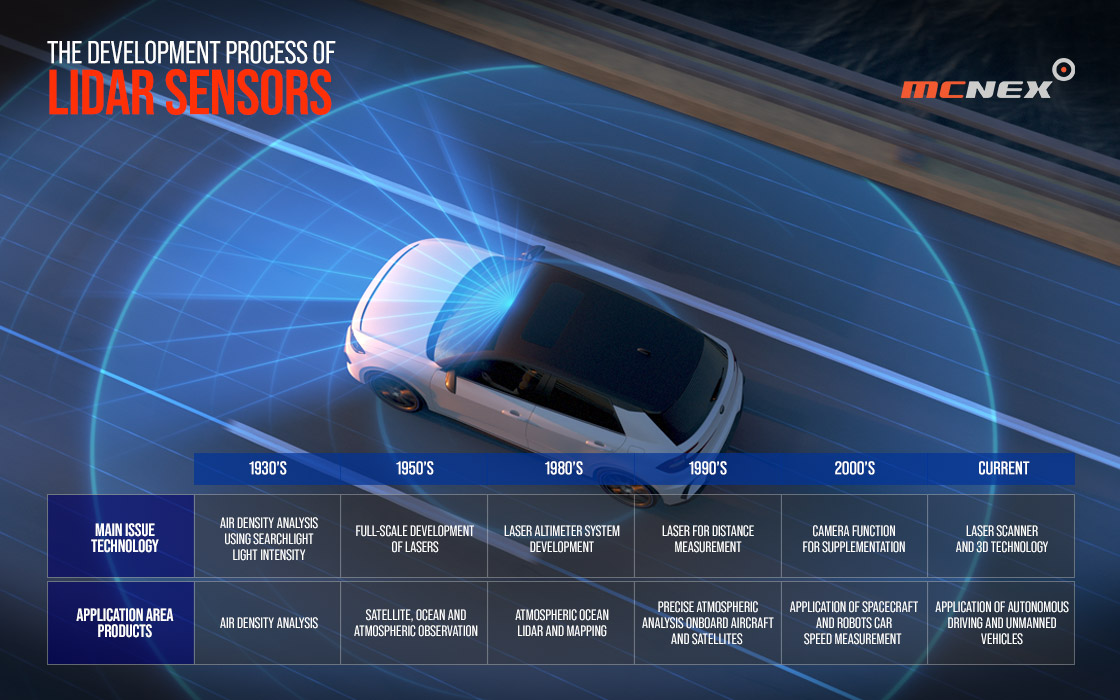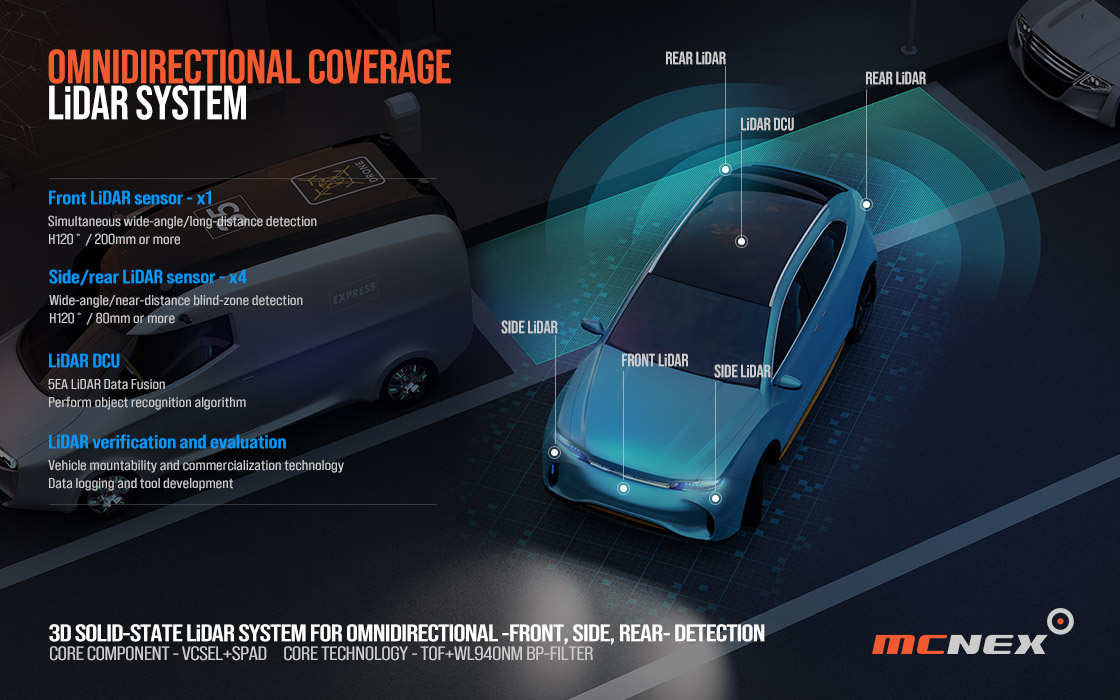NEWSROOM
Here we share with you various MCNEX stories.
- TitleMCNEX 3D Solid-State LiDAR System DATE 2024-04-29
-
MCNEX 3D Solid-State LiDAR System for omnidirectional detection
MCNEX ‘3D Solid-State LiDAR’ system
The MCNEX 3D solid-state LiDAR system is an advanced sensing system that uses laser beams to scan the surrounding environment to determine information such as distance, location, and shape of objects. This system is used in vehicles, robots, and other autonomous driving systems. It is an autonomous driving technology that senses the surrounding environment in real time to plan and adjust driving and routes.
The '3D Solid-State LiDAR' system is a LiDAR (Light Detection and Ranging) technology that scans and senses the surrounding environment in three dimensions, relying on moving parts such as rotating mirrors or rotating assemblies to scan the surroundings. Unlike traditional mechanical LiDAR systems, solid-state LiDAR systems use stationary components, typically semiconductor-based devices, to emit and detect laser pulses.
In a 3D Solid-State LiDAR system, a laser is emitted from a fixed location and heads outward to scan the environment in multiple directions simultaneously. The returning laser pulse is captured by a photodetector, and the laser is reflected by an object and returned to the sensor. The time it takes is measured. By timing these reflections precisely, you can calculate distances to objects and create detailed 3D maps of your surroundings.
What is LiDAR?
LiDAR is an abbreviation for ‘Light Detection and Ranging’, pronounced as ‘lidar’, and is also called ‘laser radar’ or ‘infrared laser scanner’. Light Detection And Ranging (detection and distance measurement through light) uses near-infrared light, visible light, and ultraviolet rays to shine light on an object and detects the reflected light through an optical sensor to measure the distance (remote sensing (using the sensor from a remote location) Light/Laser Imaging Detection And Ranging irradiates near-infrared laser light in a pulsed state and measures the time difference from when it touches the object to when it is reflected.
It accurately detects not only the distance to the object, but also its location and shape, recognizes the surrounding environment without driver intervention, and controls the vehicle by independently determining the driving situation. The basic principle is the same as radar, but it primarily uses a pulse laser with a 905nm wavelength to deliver distance information and provides more precise location information than radar.

Key Principles of 3D Solid-State LiDAR Systems
The principle behind the 3D Solid-State LiDAR system is a sensor technology that uses lasers to measure distances and shapes in the surrounding environment.
Unlike traditional LiDAR systems that often rely on mechanical parts to rotate the laser emitter and receiver, stationary LiDAR systems have no moving parts, providing improved reliability, durability and response time, and these systems are used in a variety of applications, including autonomous driving. It plays an important role in fields such as automobiles, robotics, industrial automation, and urban planning.
1. Light Emission
The system emits a laser beam, the laser pulse propagates through the surrounding environment and when the laser beam hits an object, some of the energy is reflected back towards the LiDAR sensor. These lasers are generally generated by solid-state laser diodes. Solid-state lasers offer advantages such as compactness, reliability, and fast response time over other types of lasers. These lasers are optimal for long-distance detection and are suitable for use in environments or other environments. It can produce light of a specific wavelength that minimizes interference with the sensor.
2. Light Detection
The reflected light is detected by a receiver within the LiDAR system, and the time it takes for the laser pulse to reach the object and return is precisely measured. This time-of-flight measurement is important in determining the distance between the LiDAR sensor and the object.
3. Data Processing
LiDAR systems process time-of-flight data to calculate the distance to each point in the environment, and by scanning laser beams at various angles, the system can create a 3D point cloud representation of the surrounding space. Each point in a point cloud corresponds to a specific location in the environment and provides relevant distance information.
4. System Integration
LiDAR systems are integrated into the vehicle's broader control system, providing direct information to decision-making algorithms that manage steering, braking and acceleration. Accurate LiDAR data enables precise route planning and safe navigation of the complex environment of the road.

Advantages of 3D Solid-State LiDAR Systems
Compact design
Typically more compact than traditional mechanical LiDAR systems, they integrate all required components, including the laser emitter, receiver, and signal processing electronics, into a single device or package, and this compact design allows them to be used in a variety of applications, including autonomous vehicles, drones, and portable devices. Can be easily integrated into.
Stationary laser technology
3D Solid-State LiDAR systems utilize stationary laser diodes as light sources. Stationary lasers offer advantages such as high reliability, long life, fast response time, and are also more energy efficient than other types of lasers, making them ideal for battery-powered applications.
High speed scanning
3D Solid-State LiDAR systems can quickly scan the surrounding environment. By emitting laser pulses and capturing reflected light at high frequencies, it enables real-time 3D mapping and object detection, and this high-speed scanning capability is critical for applications that require fast decision-making, such as autonomous driving and robotics.
Long range detection and high resolution
3D Solid-State LiDAR systems can accurately measure distances to objects hundreds of meters away with long-range detection capabilities while maintaining high resolution and generate detailed 3D points with millions of points. The combination of long range and high resolution enables accurate positioning and mapping in a variety of environments.
Multi-beam configuration
3D Solid-State LiDAR systems use multi-beam scanning configurations to improve coverage and resolution. By splitting the laser beam into multiple beams and scanning them simultaneously or sequentially, these systems can capture more data points in less time. Multiple beam configurations improve the overall efficiency and effectiveness of LiDAR-based recognition systems.
Reliable and durable
3D Solid-State LiDAR systems are designed to withstand harsh environmental conditions and operate reliably in a variety of scenarios. Compared to traditional rotating LiDAR systems, there is less mechanical wear and damage, lower maintenance requirements and longer operating life.
Integration with other sensors
3D Solid-State LiDAR systems are often integrated with other sensors such as cameras, radars, and IMUs to provide comprehensive perception capabilities. These sensor fusion technologies combine the advantages of different sensor modalities and improve overall system performance, especially in challenging scenarios such as low-light conditions or severe weather.
Various applications
3D Solid-State LiDAR systems are technologies that can improve safety, efficiency, and productivity in a variety of areas across a wide range of industries, including autonomous vehicles, robotics, industrial automation, agriculture, forestry, environmental monitoring, and urban planning.